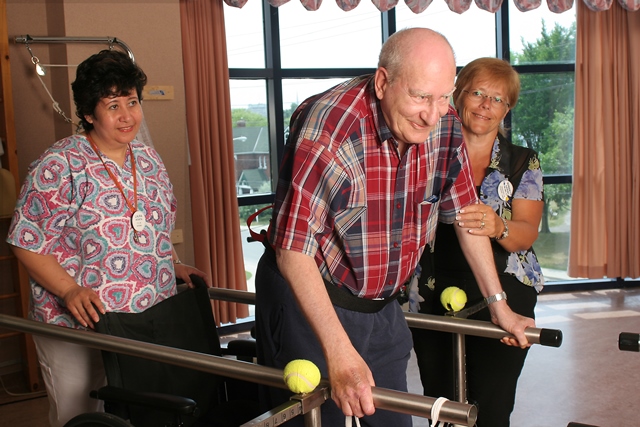Stroke is one of the leading causes of disability and death in Canada. Out of every 100 people who experience a stroke, 15 die, 10 recover completely, 25 recover with a minor impairment or disability, 40 are left with moderate to severe impairment and 10 are so severely impacted that they require long-term care (QBP Clinical Handbook for Stroke, 2016). In long-term care (LTC), 21.3 per cent of residents have had a stroke (Continuing Care Reporting System, CIHI, 2014/15) and stroke is the third most common diagnosis in LTC residents (Price Waterhouse Cooper, 2001).
Stroke is a medical emergency caused by an interruption in blood flow to the brain either due to a blood clot (ischemic stroke) or uncontrolled bleeding (hemorrhagic stroke). Knowing the signs of stroke and reacting quickly can significantly impact on stroke recovery. For every minute that stroke treatment is delayed, the average patient loses 1.9 million brain cells (QBP Clinical Handbook for Stroke, 2016).
Rapid and appropriate emergency management after a stroke can substantially improve health outcomes For eligible patients experiencing an ischemic stroke, emergency departments may give tissue plasminogen activator (tPA), a clot busting medication, or perform an Endovascular Thrombectomy (EVT) which is an image guided mechanical clot retrieval to remove the source of the blockage. These treatments can significantly lessen brain damage thereby reducing the severity of deficits that can result from a stroke. Not all hospitals can provide these treatments and there are time windows, so it is critical to call 911 as paramedics will transfer the patient to the appropriate location and alert the stroke team in advance. A rapid response to the onset of new stroke symptoms should be regarded as a medical emergency and, in LTC, should be treated according to individual resident care plans and in accordance with their advanced care directive. Remember, time is brain!
Transient Ischemic Attack (TIA) is also known as a “mini-stroke”. It is caused by a temporary blockage to blood flow in the brain with transient symptoms lasting from minutes to up to 24 hours. TIAs are considered warning events and should be taken very seriously as the risk of a subsequent stroke within 7 days can be as high as 36% (Canadian Stroke Best Practice Recommendations, 2014). As with stroke, emergency treatment is needed and a rapid referral to a stroke prevention clinic should be arranged for follow-up.
Residents in LTC who have experienced a stroke can require complex care. Common effects of stroke include:
- Paralysis or weakness on one side of the body
- Vision problems (e.g. blurry vision, double vision or loss of visual fields)
- Communication problems (e.g. aphasia)
- Fatigue
- Incontinence
- Changes in how the person perceives or interprets the world
- Neglect or inattention (decreased or no awareness of the affected side of the body, or the environment)
- Changes in the ability to perceive touch, temperature or pressure
- Personality changes (e.g. loss of emotional control)
- Depression
- Cognitive difficulties that make it hard to remember things, solve problems, and handle everyday tasks
- Difficulty with swallowing
- Increased or decreased muscle tone on the affected side of the body
- Pain (in the affected shoulder or on the weak side of the body)
(Taking Action for Optimal Community and Long-term Stroke Care, 2016)
Depending on the type and severity of a resident’s stroke, one or more of these symptoms may be present requiring specific interventions, approaches and/or equipment to support the resident in their everyday tasks.
If you want to learn more about stroke care, stroke best practices or educational resources for residents and families, there are several options available.
- Taking Action for Optimal Community and Long-Term Stroke Care: A Resource for Healthcare Providers (TACLS), provides direction for health care providers on the provision of safe, evidence-based care for persons with stroke residing in community and long-term care settings.
- Complementing the TACLS resource are the Stroke Care Plans for Long-Term Care (available via the CorHealth Ontario website). The Stroke Care Plans for Long-Term Care cover 12 focus areas (for example cognition, communication, behaviour, mobility) and are a free resource which can be incorporated into a resident’s existing care plan.
- The Canadian Stroke Best Practice Recommendations (strokebestpractices.ca) provide an in-depth, evidence based review of stroke best practices for all elements of care, across the continuum.
- Partnering with the Stroke Community and Long Term Care Coordinator within your region to discuss strategies to incorporate best practices within your facility. Visit the CorHealth Ontario website to locate your stroke network and further contact information.
- Heart and Stroke (heartandstroke.ca) provides an overview of stroke and recovery as well as associated resources that may assist residents and families.
Future articles will provide additional information on stroke impacts and specific interventions. Stay tuned!
This article was submitted by CorHealth Ontario Stroke Community and LTC Coordinators.


